Tsoulfanidis N. Measurement and detection of radiation
Подождите немного. Документ загружается.

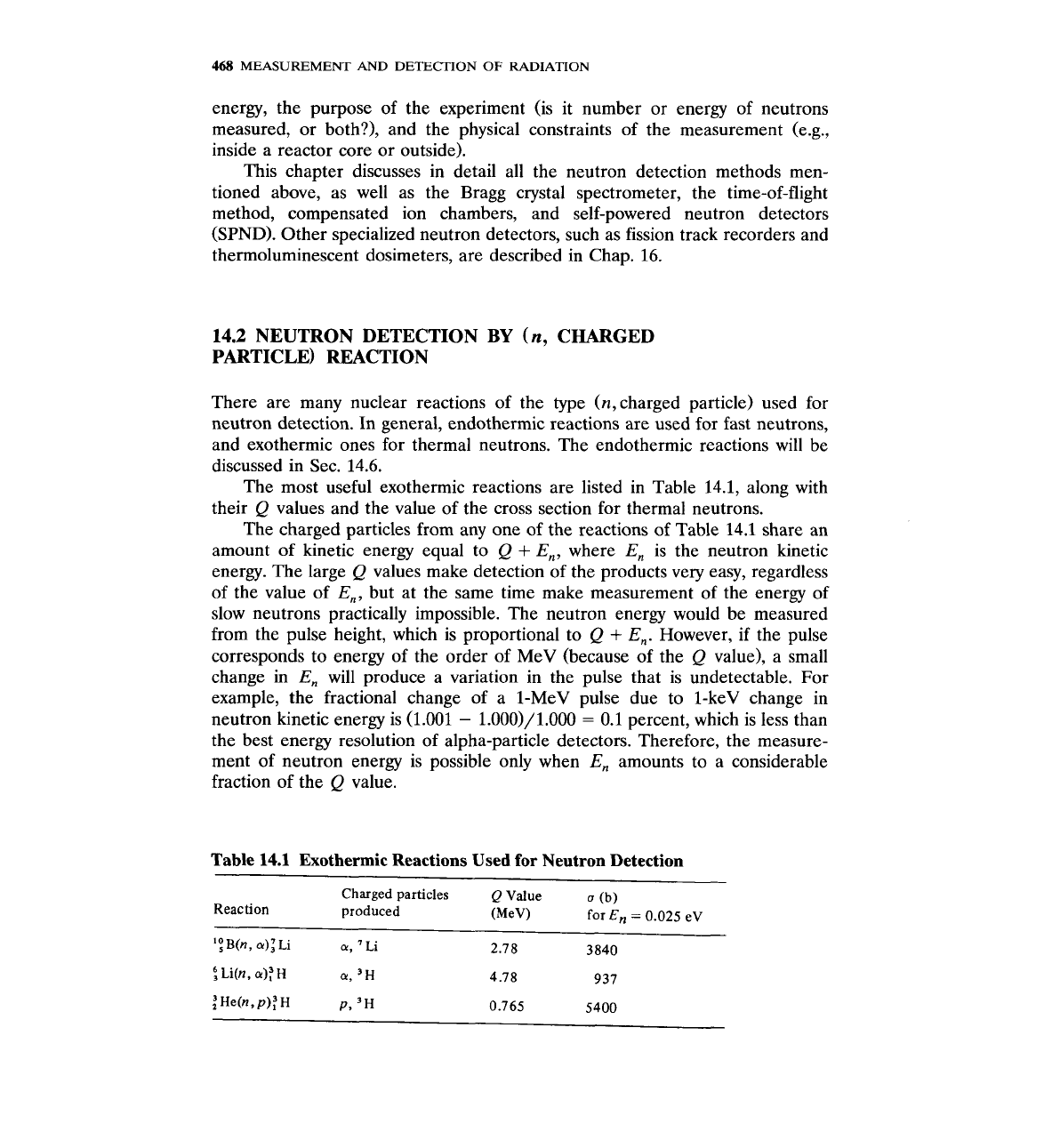
468
MEASUREMENT AND
DETEC170N
OF
RADIATION
energy, the purpose of the experiment (is it number or energy of neutrons
measured, or both?), and the physical constraints of the measurement (e.g.,
inside a reactor core or outside).
This chapter discusses in detail all the neutron detection methods men-
tioned above, as well as the Bragg crystal spectrometer, the time-of-flight
method, compensated ion chambers, and self-powered neutron detectors
(SPND). Other specialized neutron detectors, such as fission track recorders and
thermoluminescent dosimeters, are described in Chap. 16.
14.2
NEUTRON DETECTION
BY
(n,
CHARGED
PARTICLE) REACTION
There are many nuclear reactions of the type
(n,
charged particle) used for
neutron detection. In general, endothermic reactions are used for fast neutrons,
and exothermic ones for thermal neutrons. The endothermic reactions will be
discussed in
Sec. 14.6.
The most useful exothermic reactions are listed in Table 14.1, along with
their
Q
values and the value of the cross section for thermal neutrons.
The charged particles from any one of the reactions of Table 14.1 share an
amount of kinetic energy equal to
Q
+
En, where En is the neutron kinetic
energy. The large
Q
values make detection of the products very easy, regardless
of the value of En, but at the same time make measurement of the energy of
slow neutrons practically impossible. The neutron energy would be measured
from the pulse height, which is proportional to
Q
+
En. However, if the pulse
corresponds to energy of the order of MeV (because of the
Q
value), a small
change in En will produce a variation in the pulse that is undetectable. For
example, the fractional change of a 1-MeV pulse due to 1-keV change in
neutron kinetic energy is (1.001
-
1.000)/1.000
=
0.1 percent, which is less than
the best energy resolution of alpha-particle detectors. Therefore, the measure-
ment of neutron energy is possible only when
En amounts to a considerable
fraction of the
Q
value.
Table
14.1
Exothermic Reactions Used for Neutron Detection
Charged particles
Q
Value
Reaction
a
(b)
produced (MeV)
for
En
=
0.025
eV
10
B(n, or):
Li
or,
'
Li
2.78 3840
6,
Li(n, a):
H
or,
3H
4.78 937
:He(n, p):H
P,
'H
0.765 5400
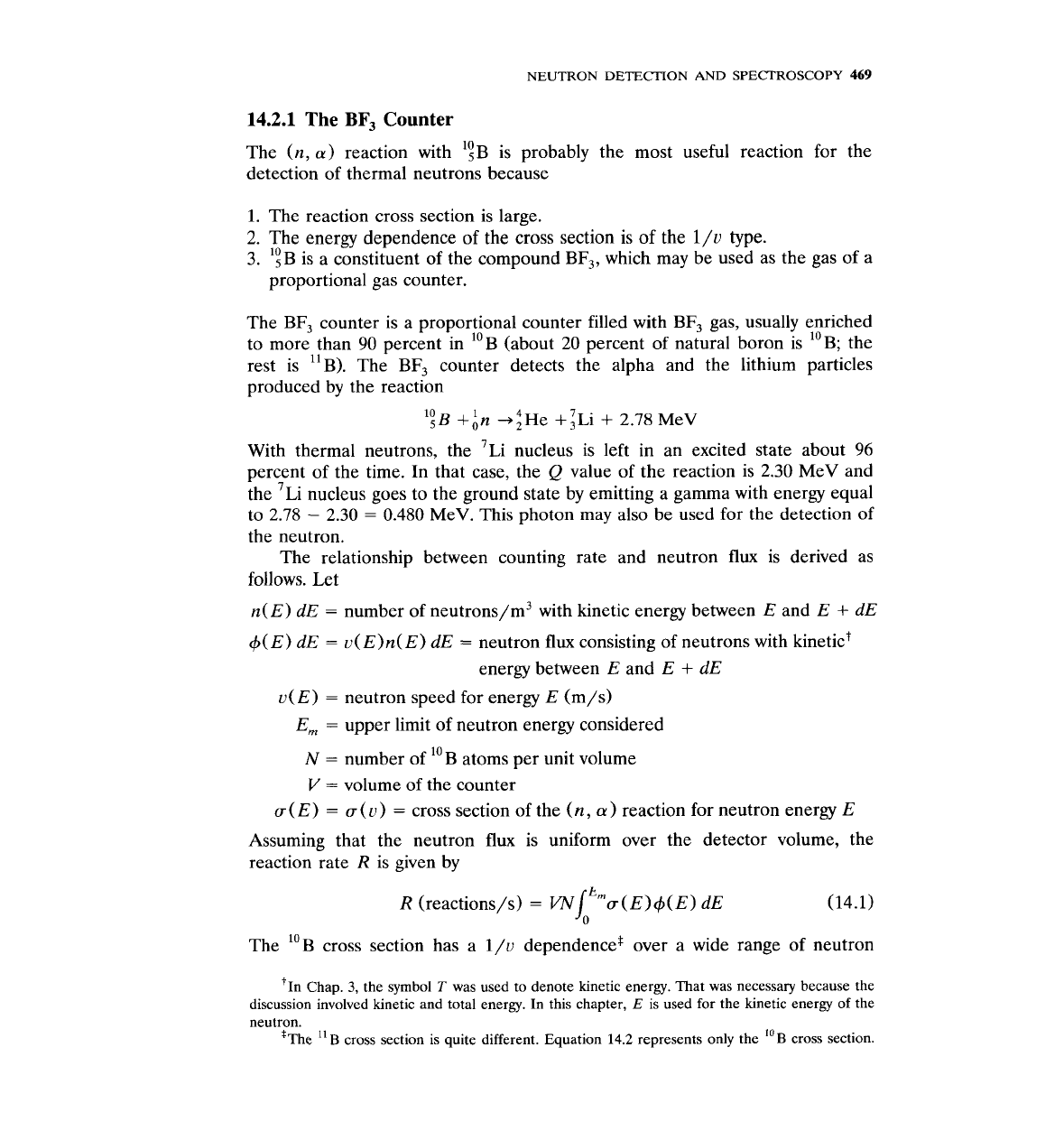
NEUTRON
DETECTION
AND
SPECTROSCOPY
469
14.2.1
The
BF,
Counter
The (n, a) reaction with
':B
is probably the most useful reaction for the
detection of thermal neutrons because
1. The reaction cross section is large.
2.
The energy dependence of the cross section is of the
l/u
type.
10
3.
5B is a constituent of the compound BF,, which may be used as the gas of a
proportional gas counter.
The BF, counter is a proportional counter filled with BF, gas, usually enriched
to more than 90 percent in
'OB
(about 20 percent of natural boron is 'OB; the
11
rest is B). The BF, counter detects the alpha and the lithium particles
produced by the reaction
10
,B
+An +i~e
+ZL~
+
2.78 MeV
With thermal neutrons, the 7~i nucleus is left in an excited state about 96
percent of the time. In that case, the
Q
value of the reaction is
2.30
MeV and
the
7~i
nucleus goes to the ground state by emitting a gamma with energy equal
to 2.78
-
2.30
=
0.480 MeV. This photon may also be used for the detection of
the neutron.
The relationship between counting rate and neutron
flux
is derived as
follows.
Let
n(E) dE
=
number of neutrons/m3 with kinetic energy between E and E
+
dE
+(E) dE
=
u( E)n( E) dE
=
neutron
flux
consisting of neutrons with kinetict
energy between E and E
+
dE
u(E)
=
neutron speed for energy E (m/s)
Em
=
upper limit of neutron energy considered
N
=
number of
'OB
atoms per unit volume
V
=
volume of the counter
a
(E)
=
a
(u)
=
cross section of the (n
,
a
)
reaction for neutron energy E
Assuming that the neutron flux is uniform over the detector volume, the
reaction rate
R
is given by
The
'OB
cross section has a
l/u
dependences over a wide range of neutron
'1n Chap.
3,
the symbol
T
was used to denote kinetic energy. That was necessary because the
discussion involved kinetic and total energy. In this chapter,
E
is used for the kinetic energy of the
neutron.
*The
"B
cross section is quite different. Equation
14.2
represents only the
'OB
cross section.
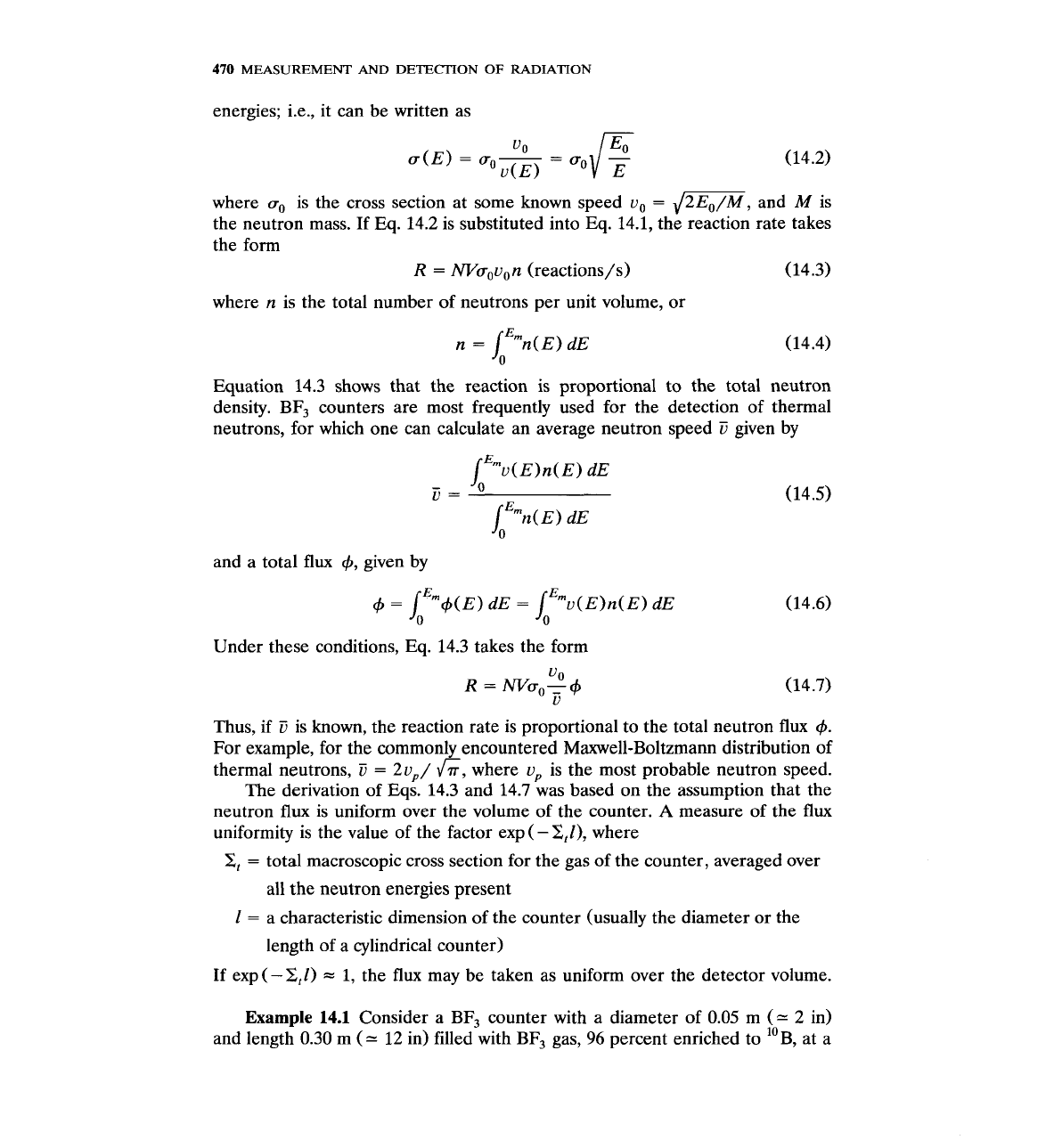
470
MEASUREMENT
AND
DETECTION
OF
RADIATION
energies; i.e., it can be written as
where
a,
is the cross section at some known speed
vo
=
and
M
is
the neutron mass. If Eq. 14.2 is substituted into Eq. 14.1, the reaction rate takes
the form
R
=
NVuouon (reactions/s) (14.3)
where n is the total number of neutrons per unit volume, or
n
=
AEmn(E)
dE
(14.4)
Equation 14.3 shows that the reaction is proportional to the total neutron
density.
BF, counters are most frequently used for the detection of thermal
neutrons, for which one can calculate an average neutron speed
E
given by
and a total
flux
4, given by
Under these conditions, Eq. 14.3 takes the form
Thus, if
E
is known, the reaction rate is proportional to the total neutron
flux
4.
For example, for the commonly encountered Maxwell-Boltzmann distribution of
thermal neutrons,
E
=
2vp/
&,
where up is the most probable neutron speed.
The derivation of Eqs. 14.3 and 14.7 was based on the assumption that the
neutron
flux
is uniform over the volume of the counter.
A
measure of the
flux
uniformity is the value of the factor exp
(
-
&I),
where
Z,
=
total macroscopic cross section for the gas of the counter, averaged over
all the neutron energies present
I
=
a characteristic dimension of the counter (usually the diameter or the
length of a cylindrical counter)
If exp(-Z,l)
-
1,
the
flux
may be taken as uniform over the detector volume.
Example
14.1
Consider a BF, counter with a diameter of 0.05 m
(-
2 in)
and length 0.30 m
(-
12 in) filled with BF, gas,
96
percent enriched to 'OB, at a
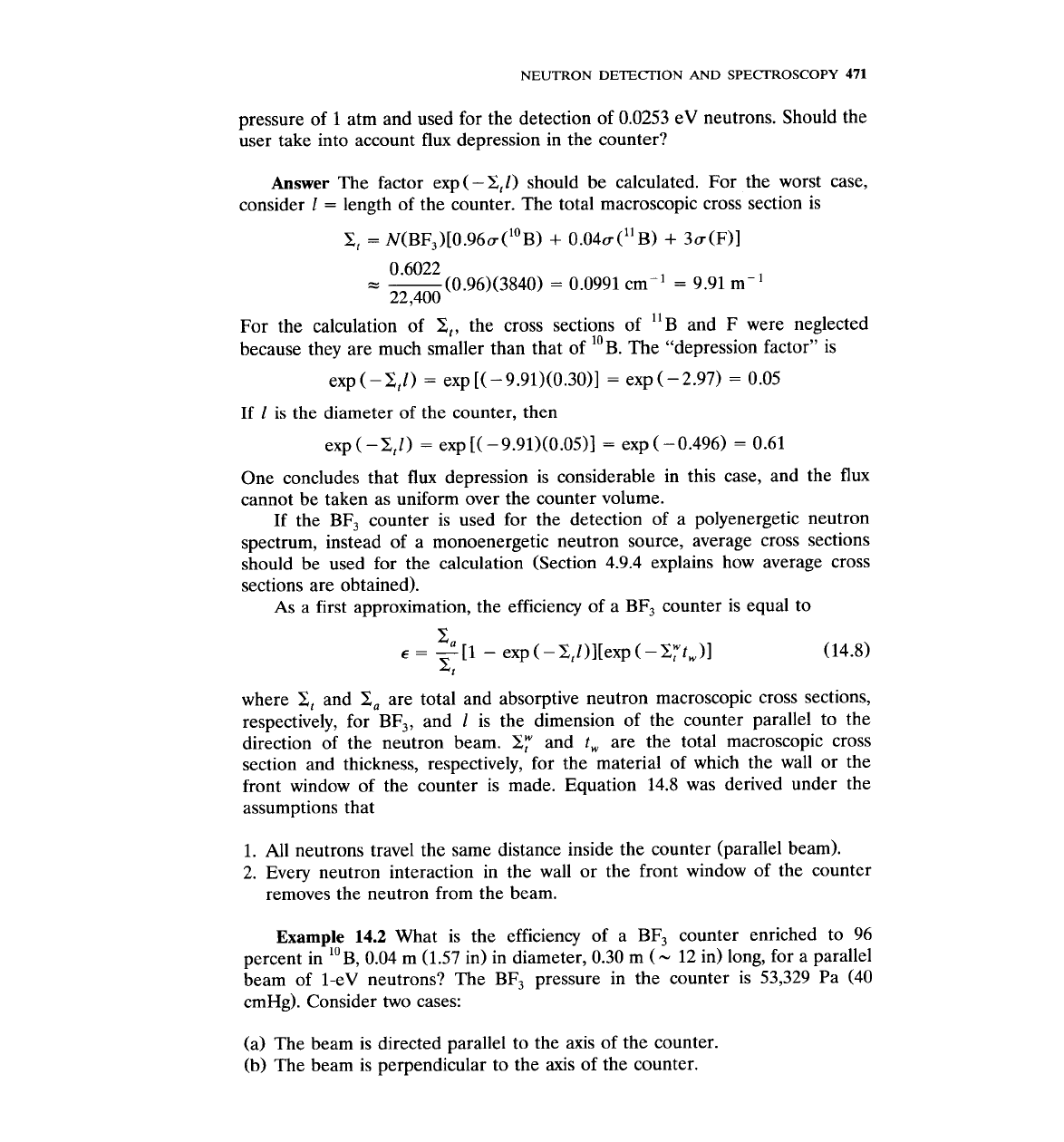
NEUTRON
DETECTION
AND
SPECTROSCOPY
471
pressure of
1
atm and used for the detection of 0.0253 eV neutrons. Should the
user take into account
flux
depression in the counter?
Answer
The factor exp(-C,1) should be calculated. For the worst case,
consider 1
=
length of the counter. The total macroscopic cross section is
2,
=
N(BF,)[O.~~U('~B)
+
0.04u("B)
+
3u(F)1
For the calculation of C,, the cross sections of
"B
and F were neglected
because they are much smaller than that of
'OB.
The "depression factor" is
exp (-&I)
=
exp [(-9.91)(0.30)]
=
exp (-2.97)
=
0.05
If
1
is the diameter of the counter, then
One concludes that
flux
depression is considerable in this case, and the
flux
cannot be taken as uniform over the counter volume.
If the BF, counter is used for the detection of a polyenergetic neutron
spectrum, instead of a monoenergetic neutron source, average cross sections
should be used for the calculation (Section 4.9.4 explains how average cross
sections are obtained).
As
a first approximation, the efficiency of a
BF,
counter is equal to
a
E
=
--[I
-
exp (-2,l)l[exp (-2:t,)l
(14.8)
Xt
where
C,
and C, are total and absorptive neutron macroscopic cross sections,
respectively, for BF,, and
1
is the dimension of the counter parallel to the
direction of the neutron beam.
2:
and t, are the total macroscopic cross
section and thickness, respectively, for the material of which the wall or the
front window of the counter is made. Equation 14.8 was derived under the
assumptions that
1. All neutrons travel the same distance inside the counter (parallel beam).
2. Every neutron interaction in the wall or the front window of the counter
removes the neutron from the beam.
Example
14.2
What is the efficiency of a BF, counter enriched to 96
percent in 'OB, 0.04 m (1.57 in) in diameter, 0.30 m
(
-
12 in) long, for a parallel
beam of 1-eV neutrons? The BF, pressure in the counter is 53,329 Pa (40
cmHg). Consider two cases:
(a) The beam is directed parallel to the axis of the counter.
(b) The beam is perpendicular to the axis of the counter.
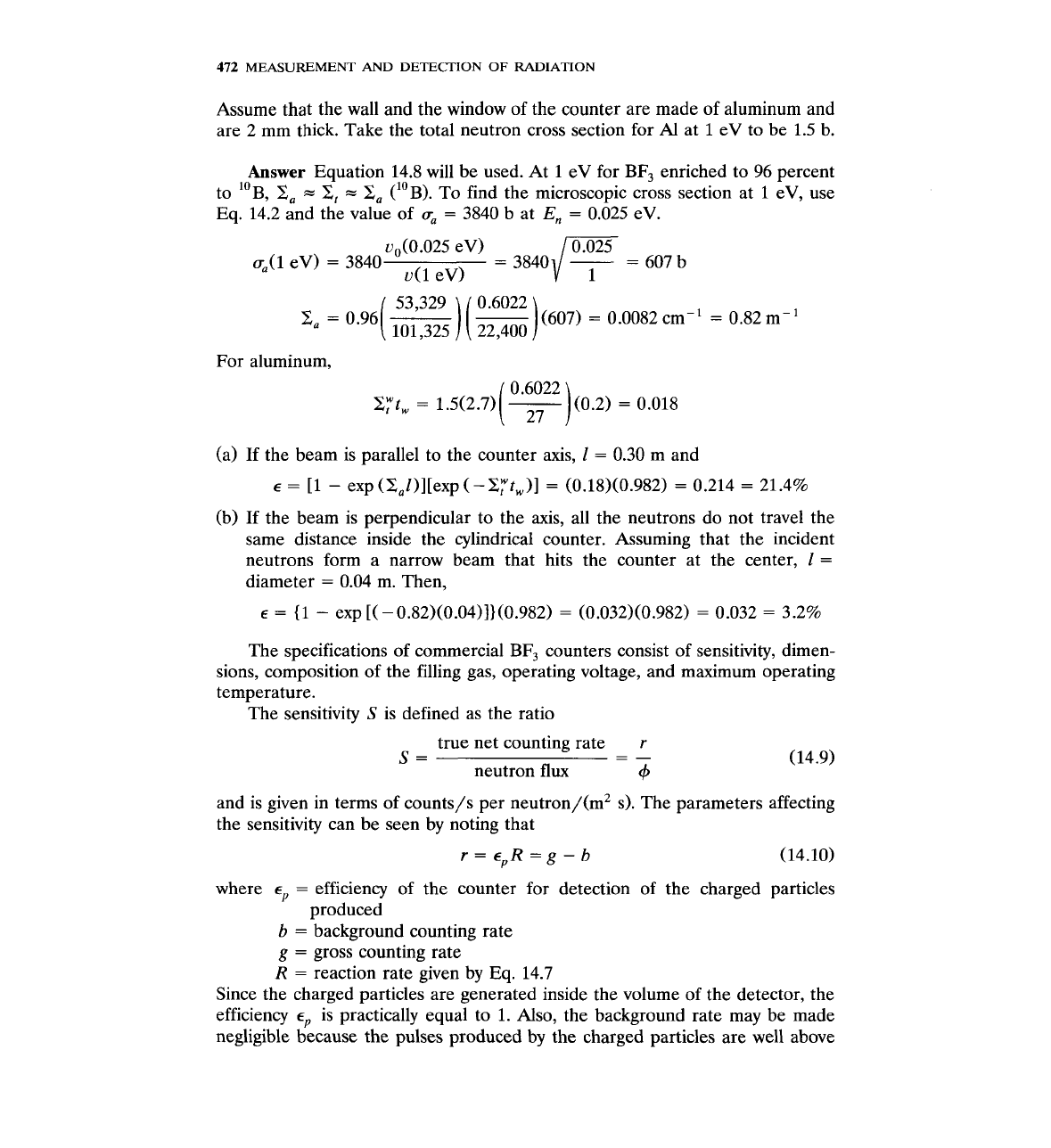
472
MEASUREMENT
AND
DETECTION
OF
RADIATION
Assume that the wall and the window of the counter are made of aluminum and
are 2 mm thick. Take the total neutron cross section for
A1
at
1
eV to be 1.5 b.
Answer
Equation 14.8 will be used. At
1
eV for BF, enriched to 96 percent
to 'OB,
C,
=
C,
=
C, ('OB). To find the microscopic cross section at
1
eV, use
Eq. 14.2 and the value of ua
=
3840 b at
En
=
0.025 eV.
For aluminum,
(a) If the beam is parallel to the counter axis,
1
=
0.30 m and
E
=
[l
-
exp (C,l)][exp (-Cyt,)]
=
(0.18)(0.982)
=
0.214
=
21.4%
(b) If the beam is perpendicular to the axis, all the neutrons do not travel the
same distance inside the cylindrical counter. Assuming that the incident
neutrons form a narrow beam that hits the counter at the center,
1
=
diameter
=
0.04 m. Then,
E
=
11
-
exp
[(
-0.82)(0.04)1}(0.982)
=
(0.032)(0.982)
=
0.032
=
3.2%
The specifications of commercial BF, counters consist of sensitivity, dimen-
sions, composition of the filling gas, operating voltage, and maximum operating
temperature.
The sensitivity
S
is defined as the ratio
true net counting rate
r
S
=
-
-
-
neutron
flux
4
and is given in terms of counts/s per neutron/(m2 s). The parameters affecting
the sensitivity can be seen by noting that
r=epR=g-b
(14.10)
where
ep
=
efficiency of the counter for detection of the charged particles
produced
b
=
background counting rate
g
=
gross counting rate
R
=
reaction rate given by
Eq.
14.7
Since the charged particles are generated inside the volume of the detector, the
efficiency
E,
is practically equal to
1.
Also, the background rate may be made
negligible because the pulses produced by the charged particles are well above
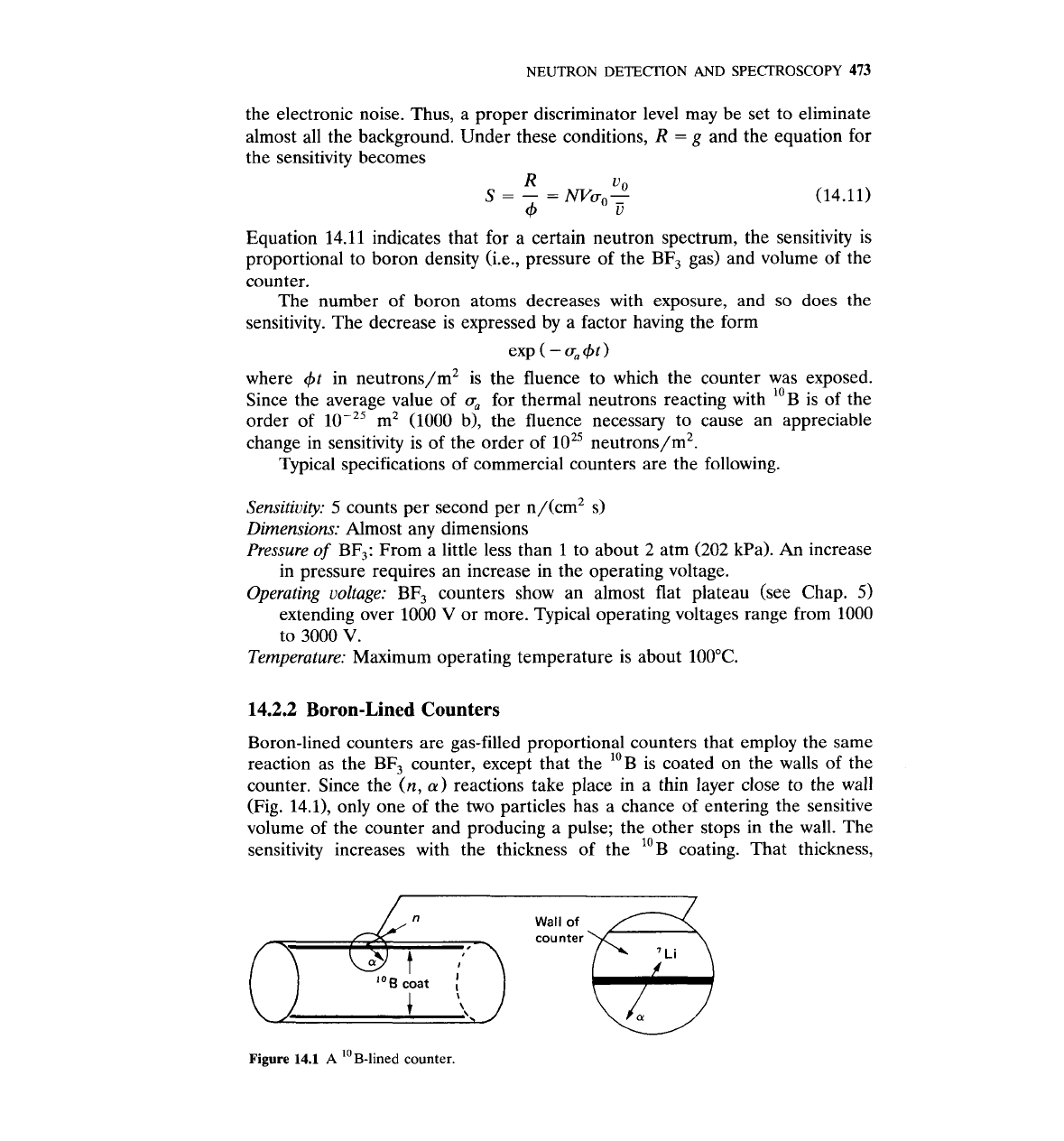
NEUTRON DETECTION
AND
SPECTROSCOPY
473
the electronic noise. Thus, a proper discriminator level may be set to eliminate
almost all the background. Under these conditions,
R
=
g and the equation for
the sensitivity becomes
Equation 14.11 indicates that for a certain neutron spectrum, the sensitivity is
proportional to boron density (i.e., pressure of the BF, gas) and volume of the
counter.
The number of boron atoms decreases with exposure, and so does the
sensitivity. The decrease is expressed by a factor having the form
exp
(
-aa&)
where
4t
in neutrons/m2 is the fluence to which the counter was exposed.
Since the average value of
q
for thermal neutrons reacting with
'OB
is of the
order of m2 (1000 b), the fluence necessary to cause an appreciable
change in sensitivity is of the order of
neutrons/m2.
Typical specifications of commercial counters are the following.
Sensitivity:
5
counts per second per n/(cm2 s)
Dimensions: Almost any dimensions
Pressure
of
BF,: From a little less than
1
to about 2 atm (202 kPa).
An
increase
in pressure requires an increase in the operating voltage.
Operating voltage:
BF,
counters show an almost flat plateau (see Chap.
5)
extending over 1000
V
or more. Typical operating voltages range from 1000
to 3000
V.
Temperature: Maximum operating temperature is about 100°C.
14.2.2 Boron-Lined Counters
Boron-lined counters are gas-filled proportional counters that employ the same
10
reaction as the BF, counter, except that the
B is coated on the walls of the
counter. Since the
(n,
a)
reactions take place in a thin layer close to the wall
(Fig. 14.0, only one of the two particles has a chance of entering the sensitive
volume of the counter and producing a pulse; the other stops in the wall. The
10
sensitivity increases with the thickness of the
B coating. That thickness,
n
Wall
of
counter
t
1'
Figure
14.1
A
'O
B-lined
counter.
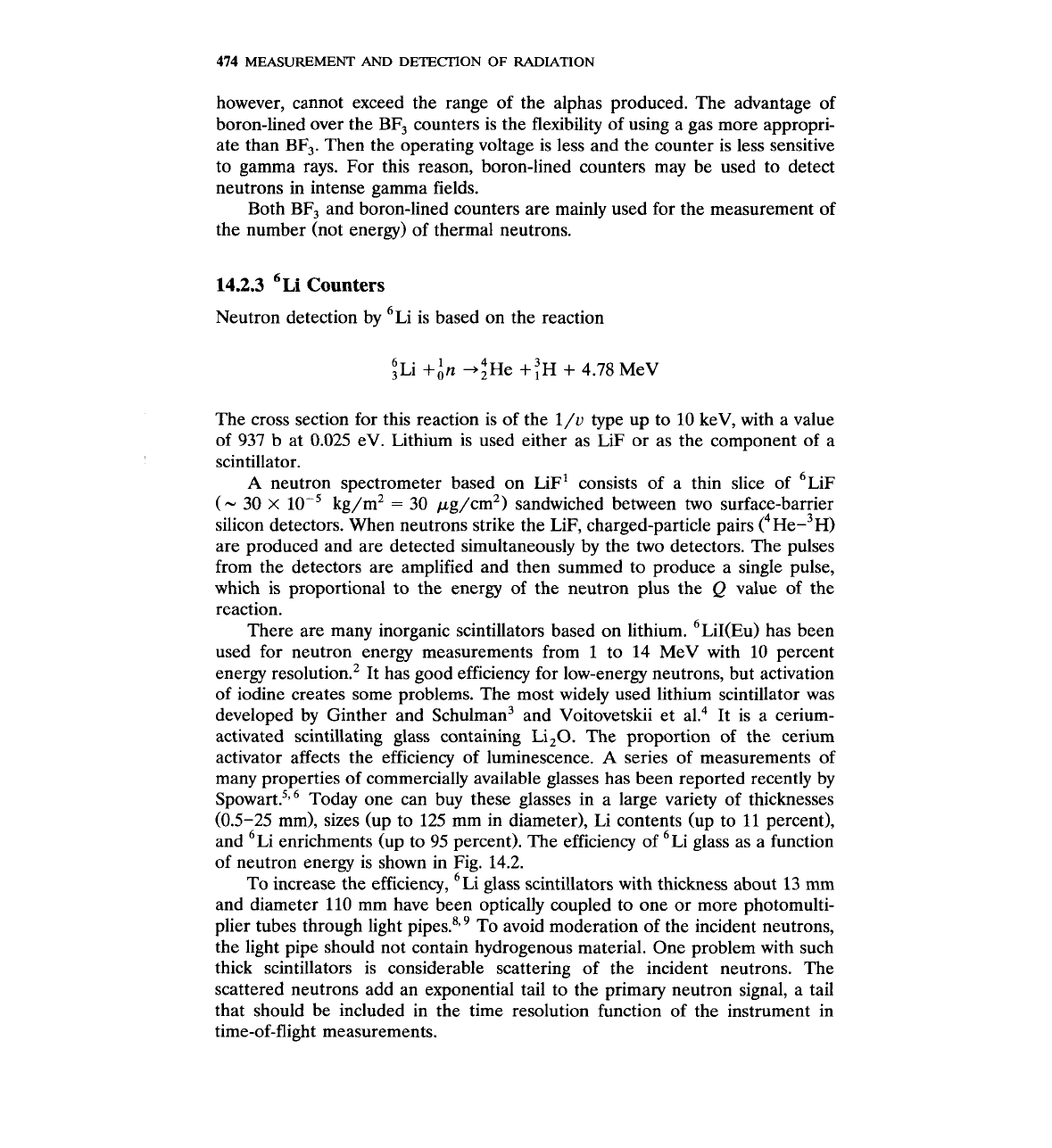
474
MEASUREMENT
AND
DETECTION
OF
RADIATION
however, cannot exceed the range of the alphas produced. The advantage of
boron-lined over the BF, counters is the flexibility of using a gas more appropri-
ate than
BF,. Then the operating voltage is less and the counter is less sensitive
to gamma rays. For this reason, boron-lined counters may be used to detect
neutrons in intense gamma fields.
Both BF3 and boron-lined counters are mainly used for the measurement of
the number (not energy) of thermal neutrons.
14.2.3
6~i
Counters
Neutron detection by 6~i is based on the reaction
The cross section for this reaction is of the l/v type up to 10 keV, with a value
of 937
b
at 0.025 eV. Lithium is used either as LiF or as the component of a
scintillator.
A
neutron spectrometer based on
L~F'
consists of a thin slice of 6~i~
(-
30
x
low5
kg/m2
=
30 pg/cm2) sandwiched between two surface-barrier
silicon detectors. When neutrons strike the LiF, charged-particle pairs (4~e-3~)
are produced and are detected simultaneously by the two detectors. The pulses
from the detectors are amplified and then summed to produce a single pulse,
which is proportional to the energy of the neutron plus the
Q
value of the
reaction.
6
There are many inorganic scintillators based on lithium. LiI(Eu) has been
used for neutron energy measurements from
1
to 14 MeV with 10 percent
energy reso~ution.~ It has good efficiency for low-energy neutrons, but activation
of iodine creates some problems. The most widely used lithium scintillator was
developed by Ginther and Schulman3 and Voitovetskii et
al.4 It is a cerium-
activated scintillating glass containing Li20. The proportion of the cerium
activator affects the efficiency of luminescence.
A
series of measurements of
many properties of commercially available glasses has been reported recently by
Sp~wart.~,~ Today one can buy these glasses in a large variety of thicknesses
(0.5-25 mm), sizes (up to 125 mm in diameter), Li contents (up to
11
percent),
and 6~i enrichments (up to 95 percent). The efficiency of 6~i glass as a function
of neutron energy is shown in Fig. 14.2.
6
To increase the efficiency, Li glass scintillators with thickness about 13 mm
and diameter 110 mm have been optically coupled to one or more photomulti-
plier tubes through light To avoid moderation of the incident neutrons,
the light pipe should not contain hydrogenous material. One problem with such
thick scintillators is considerable scattering of the incident neutrons. The
scattered neutrons add an exponential tail to the primary neutron signal, a tail
that should be included in the time resolution function of the instrument in
time-of-flight measurements.
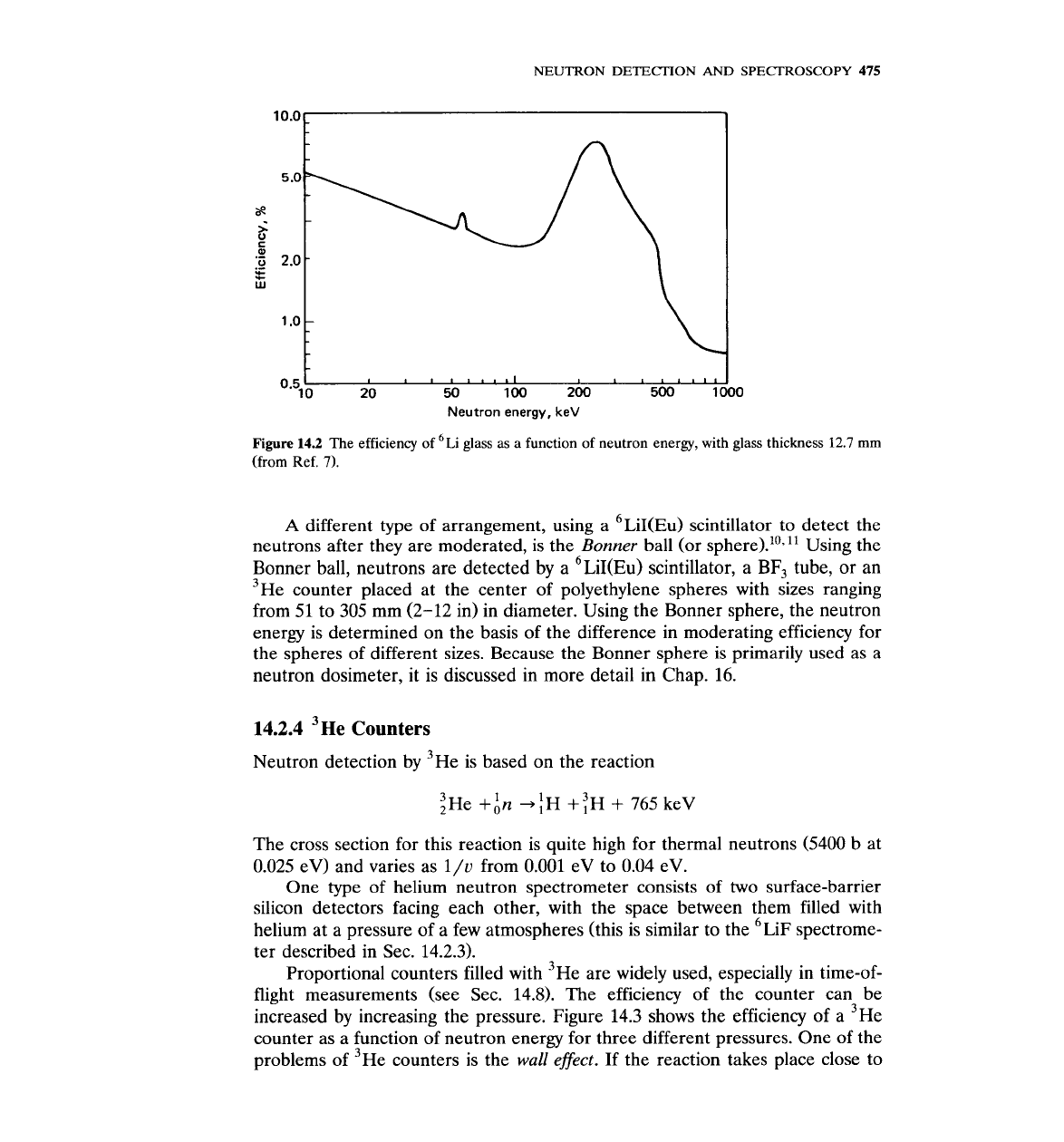
NEUTRON
DETECTION
AND
SPECTROSCOPY
475
0.5
I
10
20
50
100 200 500 11
Neutron
energy,
keV
Figure 14.2
The efficiency of 6~i glass as
a
function of neutron energy, with glass thickness
12.7
mm
(from Ref.
7).
A
different type of arrangement, using a 6~i~(~u) scintillator to detect the
neutrons after they are moderated, is the
Bonner
ball (or sphere).lO." Using the
Bonner ball, neutrons are detected by a 6~i~(~u) scintillator, a BF3 tube, or an
3
He counter placed at the center of polyethylene spheres with sizes ranging
from 51 to 305 mm (2-12 in) in diameter. Using the Bonner sphere, the neutron
energy is determined on the basis of the difference in moderating efficiency for
the spheres of different sizes. Because the Bonner sphere is primarily used as a
neutron dosimeter, it is discussed in more detail in Chap. 16.
14.2.4
3~e
Counters
Neutron detection by 3~e is based on the reaction
The cross section for this reaction is quite high for thermal neutrons (5400 b at
0.025 eV) and varies as
l/u
from 0.001 eV to 0.04 eV.
One type of helium neutron spectrometer consists of two surface-barrier
silicon detectors facing each other, with the space between them filled with
helium at a pressure of a few atmospheres (this is similar to the
6~i~ spectrome-
ter described in
Sec. 14.2.3).
Proportional counters filled with 3~e are widely used, especially in time-of-
flight measurements (see Sec. 14.8). The efficiency of the counter can be
increased by increasing the pressure. Figure 14.3 shows the efficiency of a 3~e
counter as a function of neutron energy for three different pressures. One of the
problems of 3~e counters is the
wall
effect.
If the reaction takes place close to
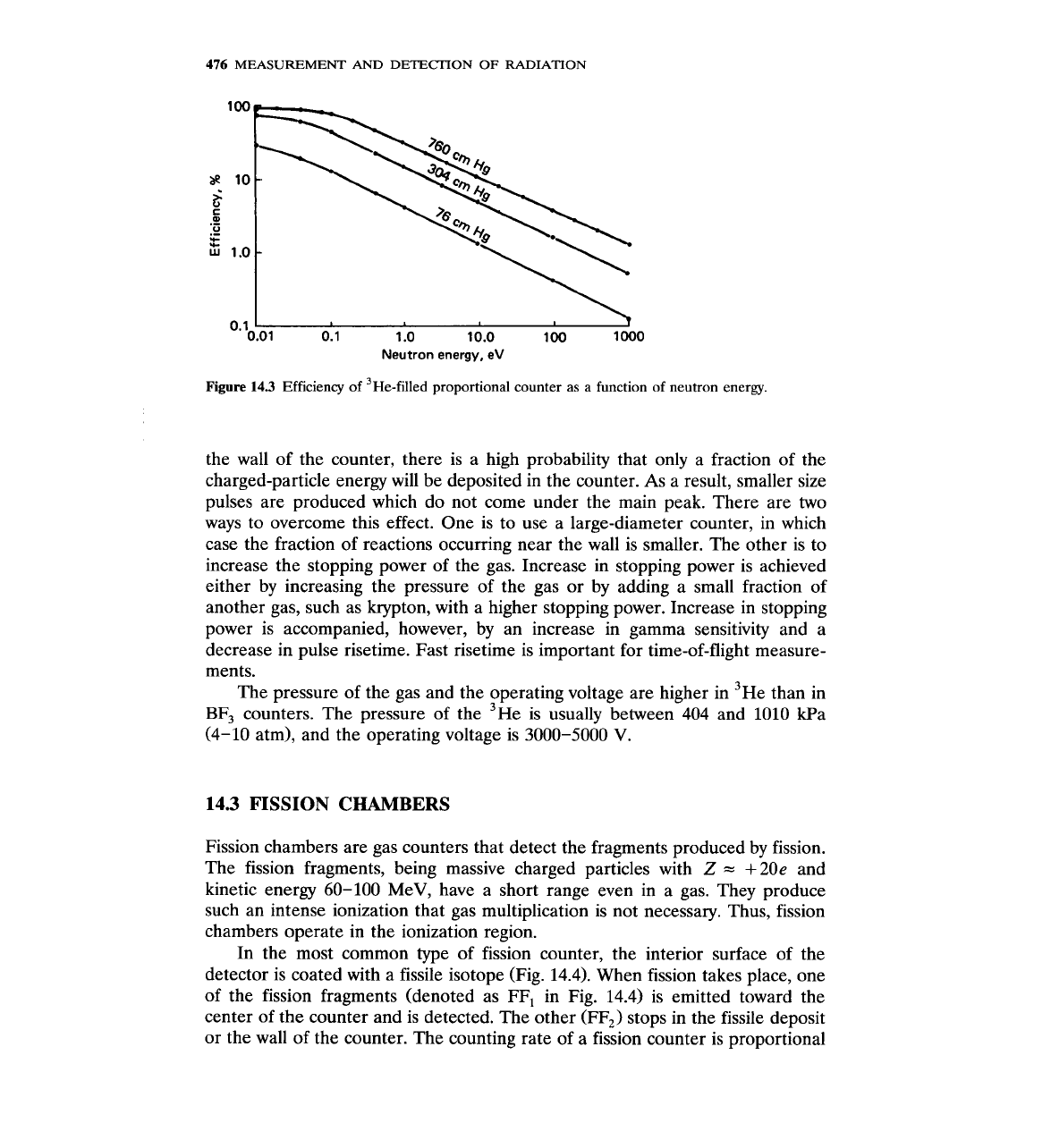
476
MEASUREMENT
AND
DETECTION
OF
RADIATION
Neutron energy, eV
Figure
14.3
Efficiency of 3~e-filled proportional counter
as
a
function of neutron energy.
the wall of the counter, there is a high probability that only a fraction of the
charged-particle energy will be deposited in the counter.
As
a result, smaller size
pulses are produced which do not come under the main peak. There are two
ways to overcome this effect. One is to use a large-diameter counter, in which
case the fraction of reactions occurring near the wall is smaller. The other is to
increase the stopping power of the gas. Increase in stopping power is achieved
either by increasing the pressure of the gas or by adding a small fraction of
another gas, such as krypton, with a higher stopping power. Increase in stopping
power is accompanied, however, by an increase in gamma sensitivity and a
decrease in pulse risetime. Fast
risetime is important for time-of-flight measure-
ments.
The pressure of the gas and the operating voltage are higher in 3~e than in
BF,
counters. The pressure of the 3~e is usually between 404 and 1010 kPa
(4-10 atm), and the operating voltage is 3000-5000 V.
14.3
FISSION
CHAMBERS
Fission chambers are gas counters that detect the fragments produced by fission.
The fission fragments, being massive charged particles with
Z
=
+20e and
kinetic energy 60-100 MeV, have a short range even in a gas. They produce
such an intense ionization that gas multiplication is not necessary. Thus, fission
chambers operate in the ionization region.
In the most common type of fission counter, the interior surface of the
detector is coated with a fissile isotope (Fig. 14.4). When fission takes place, one
of the fission fragments (denoted as
FF, in Fig. 14.4) is emitted toward the
center of the counter and is detected. The other
(FF,) stops in the fissile deposit
or the wall of the counter. The counting rate of a fission counter is proportional
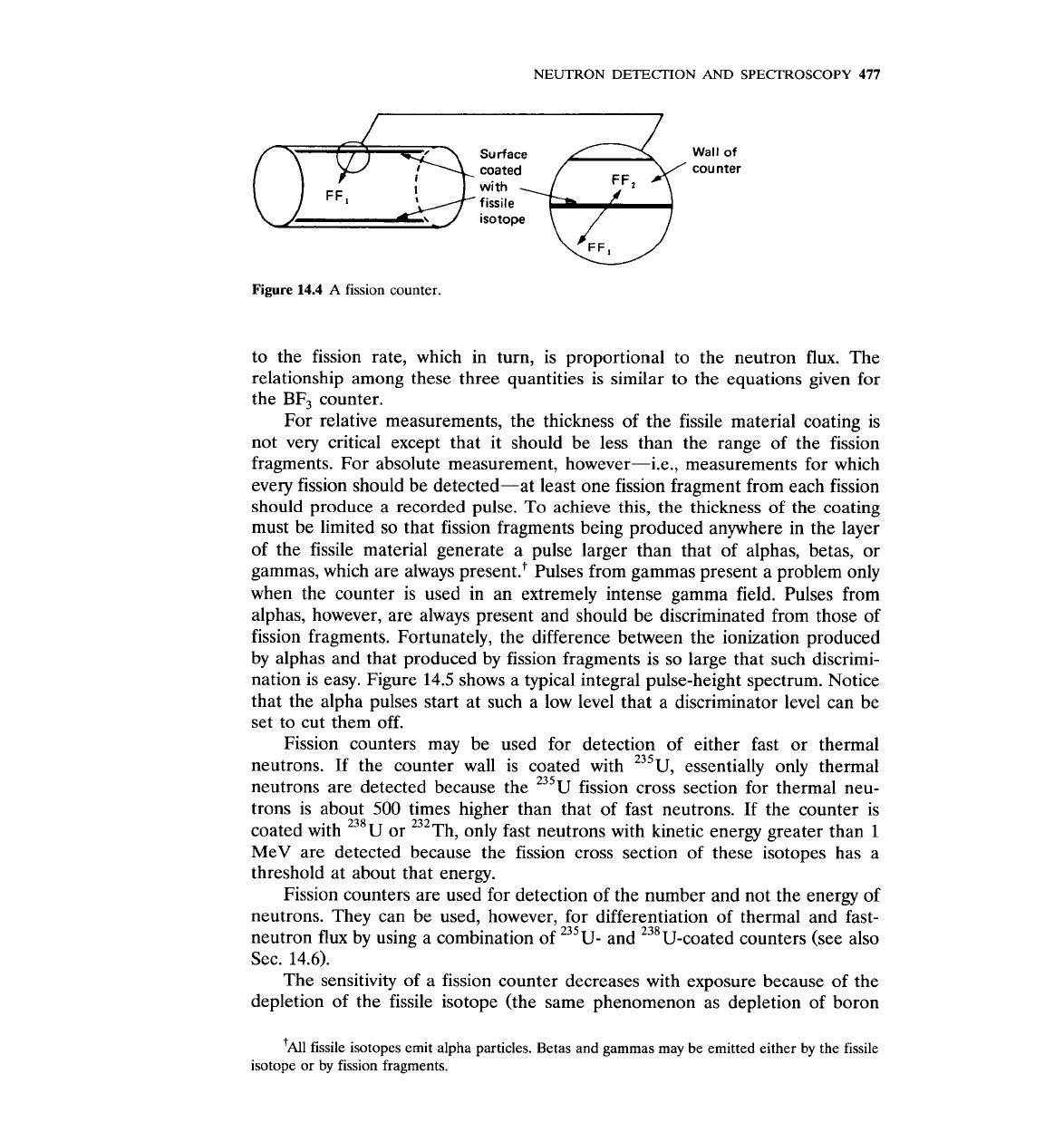
NEUTRON
DETECTION
AND
SPECTROSCOPY
477
Wall
of
counter
fissile
isotope
Figure
14.4
A
fission counter.
to the fission rate, which in turn, is proportional to the neutron
flux.
The
relationship among these three quantities is similar to the equations given for
the BF, counter.
For relative measurements, the thickness of the fissile material coating is
not very critical except that it should be less than the range of the fission
fragments. For absolute measurement, however-i.e., measurements for which
every fission should be detected-at least one fission fragment from each fission
should produce a recorded pulse. To achieve this, the thickness of the coating
must be limited so that fission fragments being produced anywhere in the layer
of the fissile material generate a pulse larger than that of alphas, betas, or
gammas, which are always
present.+ Pulses from gammas present a problem only
when the counter is used in an extremely intense gamma field. Pulses from
alphas, however, are always present and should be discriminated from those of
fission fragments. Fortunately, the difference between the ionization produced
by alphas and that produced by fission fragments is so large that such discrimi-
nation is easy. Figure
14.5
shows a typical integral pulse-height spectrum. Notice
that the alpha pulses start at such a low level that a discriminator level can be
set to cut them off.
Fission counters may be used for detection of either fast or thermal
neutrons. If the counter wall is coated with
235~, essentially only thermal
23
5
neutrons are detected because the
U fission cross section for thermal neu-
trons is about
500
times higher than that of fast neutrons. If the counter is
coated with
238~
or 232~h, only fast neutrons with kinetic energy greater than
1
MeV are detected because the fission cross section of these isotopes has a
threshold at about that energy.
Fission counters are used for detection of the number and not the energy of
neutrons. They can be used, however, for differentiation of thermal and fast-
neutron
flux
by using a combination of 235~- and 238~-coated counters (see also
Sec.
14.6).
The sensitivity of a fission counter decreases with exposure because of the
depletion of the fissile isotope (the same phenomenon as depletion of boron
'~11 fissile isotopes emit alpha particles. Betas and gammas may be emitted either by the fissile
isotope or
by
fission fragments.
